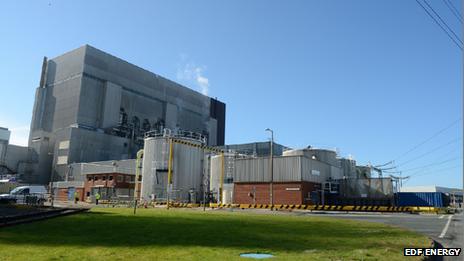Nuclear reactors may stay offline until end of year, EDF says
- Published

Four UK nuclear reactors that were shut down for safety reasons may not be back online until the end of the year, EDF Energy has said.
The reactors at the Heysham 1 and Hartlepool power stations were shut in August following a routine inspection.
EDF said there could be a "phased return to service between the end of October and the end of December, 2014".
Earlier this week National Grid announced it was seeking emergency supplies of electricity this winter.
It cited concern over potential shortages of power.
BBC industry correspondent John Moylan said that today's announcement from EDF means "up to a quarter of the nuclear fleet being offline as the UK enters winter".
All four reactors were closed after inspections found a crack in one of the boilers. The other three reactors were closed as a precautionary measure because they were of the same design.
Analysis: John Moylan, Employment and Industry Correspondent
Britain's power crunch was expected to come in 2015-16. But a series of incidents now means our spare power capacity this winter may be much tighter than expected.
The two EDF nuclear plants account for 2.3GW of electricity. The firm says they can provide up to 4% of Britain's power in periods of peak demand.
But fires at the Ferrybridge and Ironbridge coal-fired plants in the early summer, and the announcement that a gas-fired plant at Barking, in East London, is to close means that a further 1.2GW of power is also in doubt.
In June, the energy regulator Ofgem said it expected to have around 5% to 10% of spare generation this winter.
But with problems linked to five power plants, that margin has now reduced.
That uncertainty has led National Grid to take emergency measures, a year earlier than planned, to ensure extra power generation is available in the months ahead.
But will that be enough if there are further plant outages in the coming months, or if a particularly cold winter sends power demand soaring?
EDF said on Thursday that it had now had time to assess any work and draw up a timetable.
"Dates for returning the stations to service depend on the findings and completion of the inspections," the company said.
"Depending on the progress of the programme and any necessary modifications, the company expects there to be a phased return to service between the end of October and the end of December, 2014.
Any re-entry into service will have to be approved by the nuclear safety regulator, EDF said.
Power supplied by the reactors at Heysham 1 and Hartlepool accounted for about 25% of the UK's nuclear output, and about 4% of the total output of all power generated.
Alternative supplies
On Tuesday, National Grid, which runs the power distribution network, said it was seeking additional electricity supplies for winter.
The company said it was accelerating an emergency plan asking providers how much more electricity they could provide to fill a possible shortfall.
After Thursday's announcement from EDF, National Grid said: "We have already taken the sensible precaution to tender for Supplementary Balancing Reserve this winter, owing to uncertainty over plant availability.
"The tender process - which does not specify volumes - is sufficiently flexible to cater for any new information from the market."
EDF, owned by the French government, has other nuclear power stations in the UK: Hunterston and Torness in Scotland, Heysham 2 in Lancashire, Dungeness B in Kent, Hinkley Point B in Somerset and Sizewell B in Suffolk.
The UK has put a nuclear expansion programme at the heart of its low-carbon energy policy and drive for energy security.
As part of this strategy, last year the government signed a £16bn deal with EDF to build two reactors at Hinkley Point C.